高考英语书面表达——概要写作之说明文要点提取 课件(22张PPT)
文档属性
| 名称 | 高考英语书面表达——概要写作之说明文要点提取 课件(22张PPT) | 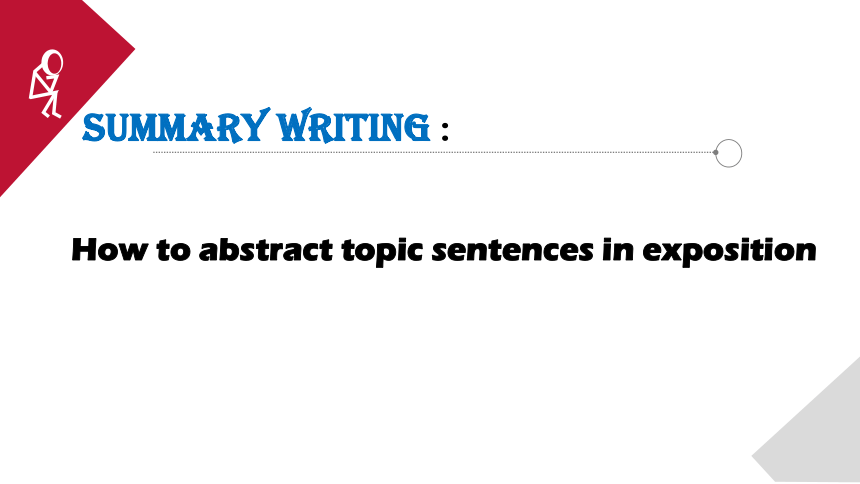 | |
| 格式 | pptx | ||
| 文件大小 | 1.5MB | ||
| 资源类型 | 教案 | ||
| 版本资源 | 通用版 | ||
| 科目 | 英语 | ||
| 更新时间 | 2021-11-13 16:54:52 | ||
图片预览

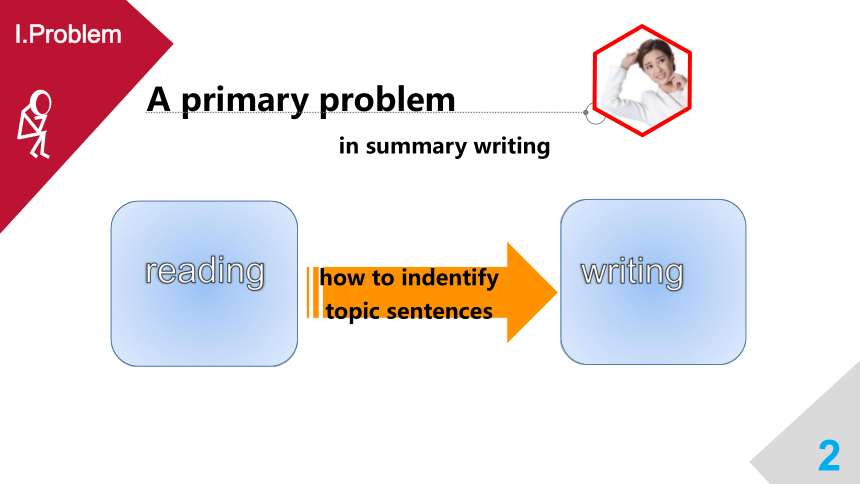
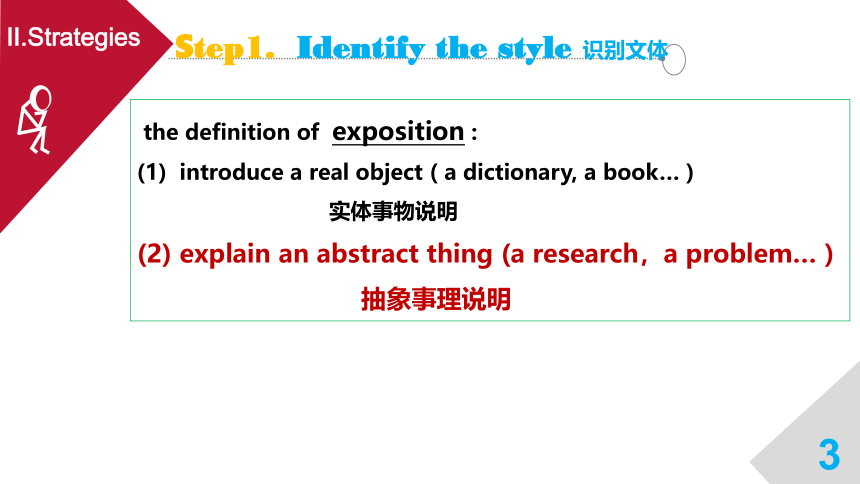
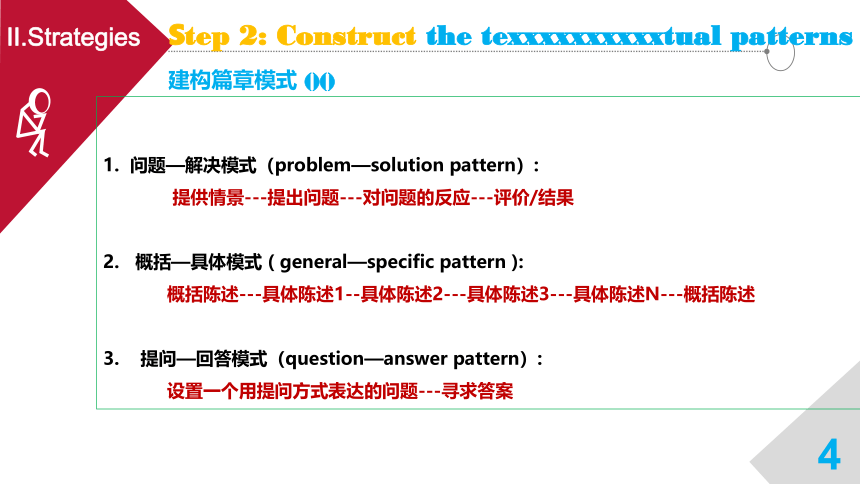
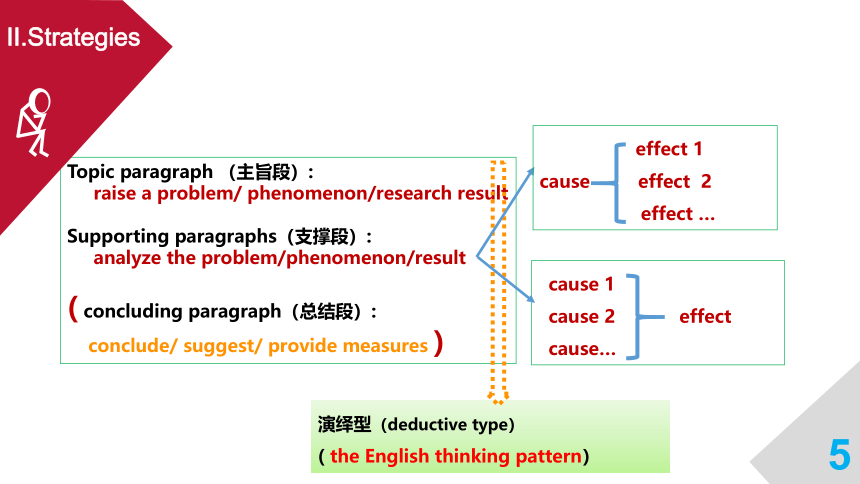
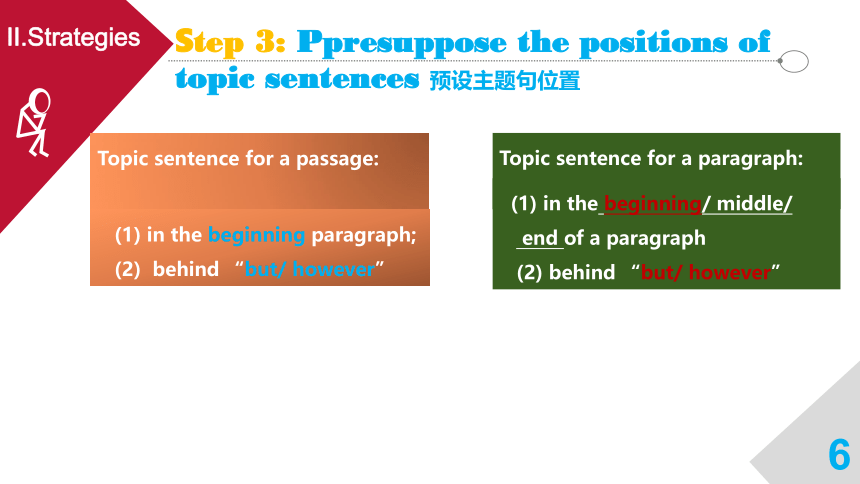
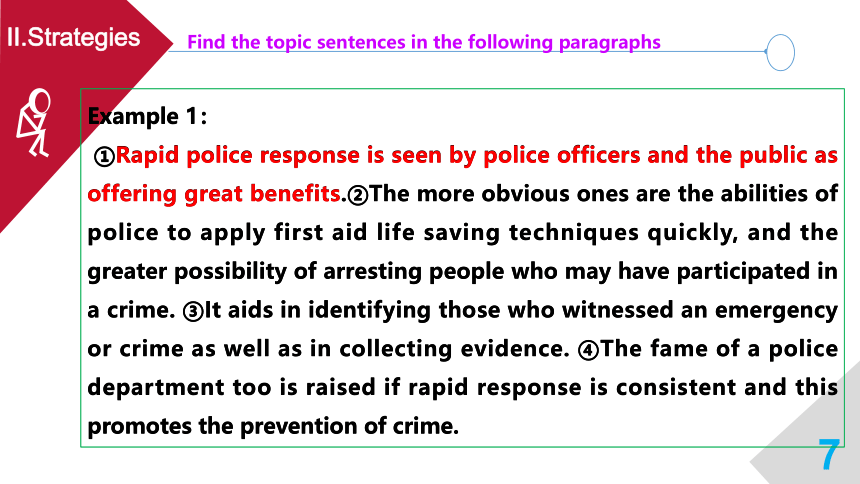
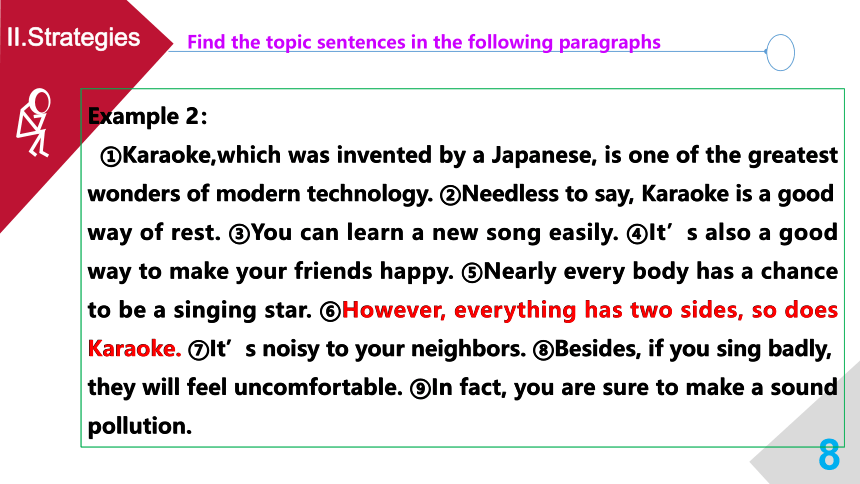
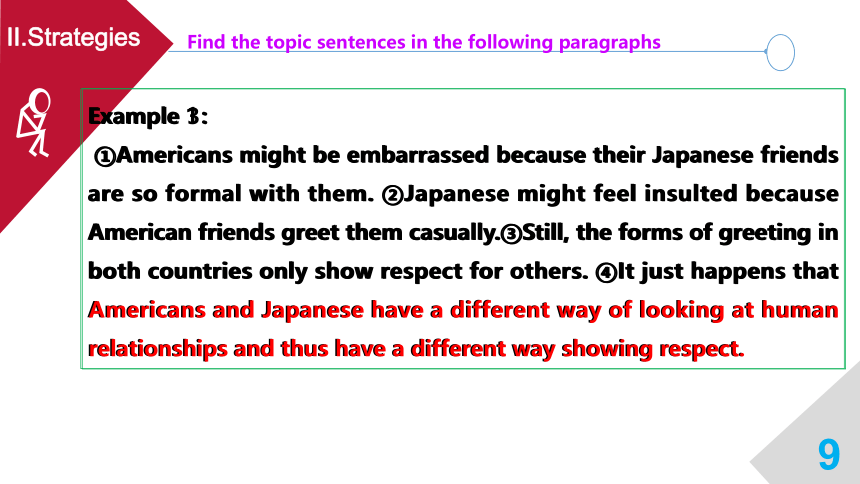
文档简介
(共22张PPT)
Identify the style
clarify the structure
find the topic sentence
take advantage of transition
Tip 1:
Delete the repeated …
Tip 2:
tips
Tip 3:
Tip 4:
Delete the too general…
clarify the logical relationship
Delete examples
Delete the information
behind the dash”
Group discussion:
Read the passage and find out the key points .
Ⅲ. Practice
1. ① “A photograph that one has taken of oneself, typically with a smart phone or webcam and uploaded to a social media website” is the definition of “selfie” in the Oxford English Dictionary. ②In fact, it wasn’t even in the dictionary until August of last year.③ It earned its place there because people are now so obsessed with (对……痴迷) selfies—we take them when we try on a new hat, play with our pets or when we meet a friend whom we haven’t seen for quite a while.
What phenomenon is raised
1. ① “A photograph that one has taken of oneself, typically with a smart phone or webcam and uploaded to a social media website” is the definition of “selfie” in the Oxford English Dictionary. ②In fact, it wasn’t even in the dictionary until August of last year.③ It earned its place there because people are now so obsessed with (对……痴迷) selfies—we take them when we try on a new hat, play with our pets or when we meet a friend whom we haven’t seen for quite a while.
Ⅲ. Practice
2. ①But is there any scientific explanation for this obsession ②Well, you should probably ask James Kilner, a neuroscientist (神经系统科学家) at University College London.
2. ①But is there any scientific explanation for this obsession ②Well, you should probably ask James Kilner, a neuroscientist (神经系统科学家) at University College London.
Ⅲ. Practice
3. ①Through our lifetime we become experts at recognizing and interpreting other people’s faces and facial expressions. ②In contrast, according to Kilner, we have a very poor understanding of our own faces since we have little experience of looking at them—we just feel them most of the time.
3. ①Through our lifetime we become experts at recognizing and interpreting other people’s faces and facial expressions. ②In contrast, according to Kilner, we have a very poor understanding of our own faces since we have little experience of looking at them—we just feel them most of the time.
4. ①This has been proved in previous studies, according to the BBC.
5. ①Kilner found that most people chose the more attractive picture. ②This suggests that we tend to think of ourselves as better-looking than we actually are. ③To further test how we actually perceive our own faces, Kilner carried out another study. ④He showed people different versions of their own portrait — the original, one that had been edited to look less attractive and one that was made more attractive—and asked them to pick the version which they thought looked most like them. ⑤They chose the more attractive version.
4. ①This has been proved in previous studies, according to the BBC.
5. ①Kilner found that most people chose the more attractive picture. ②This suggests that we tend to think of ourselves as better-looking than we actually are. ③To further test how we actually perceive our own faces, Kilner carried out another study. ④He showed people different versions of their own portrait — the original, one that had been edited to look less attractive and one that was made more attractive—and asked them to pick the version which they thought looked most like them. ⑤They chose the more attractive version.
Ⅲ. Practice
6. ①Selfies give us the power to create a photograph — by taking it from various angles, with different poses, using filters (滤色镜) and so on — that better matches our expectations with our actual faces.
7. ①“You suddenly have control in a way that you don’t have in non-virtual(非虚拟的) interactions,” Kilner told the Canada-based CTV News. ②Selfies allow you “to keep taking pictures until you manage to take one you’re happy with”, he explained.
6. ①Selfies give us the power to create a photograph — by taking it from various angles, with different poses, using filters (滤色镜) and so on — that better matches our expectations with our actual faces.
7. ①“You suddenly have control in a way that you don’t have in non-virtual(非虚拟的) interactions,” Kilner told the Canada-based CTV News. ②Selfies allow you “to keep taking pictures until you manage to take one you’re happy with”, he explained.
Ⅲ. Practice
people are now so obsessed with selfies
2. But is there any scientific explanation for this obsession
3. we have a very poor understanding of our own faces since we have
little experience of looking at them
5. we tend to think of ourselves as better-looking than we
actually are.
6. Selfies give us the power to create a photograph
present a phenomenon
analyze the reasons
reason 1
reason 2
reason 3
raise a phenomenon
analyze the reasons
Reason 1
Reason 2
Reason 3
①With an increasing number of people addicted to taking photos of themselves, a newly-made word, selfie, becomes a hit. ②Admittedly, the lack of experience of watching self-facial expression can scientifically account for the flourish of selfie.③Furthermore, people instinctively tend to choose charming portrait and beautify themselves by the selfie technique.④Thirdly, selfie allows people to have more chances to control their images and keep a psychological balance between the virtual world and the real world.
Ⅲ. Practice
raise a phenomenon
analyze the reasons
Episode 2
With the strategies of abstracting key points, finish the summary writing of the two passages , centering on its structure,
and language.
Ⅳ. Arrangement
Identify the style
clarify the structure
find the topic sentence
take advantage of transition
Tip 1:
Delete the repeated …
Tip 2:
tips
Tip 3:
Tip 4:
Delete the too general…
clarify the logical relationship
Delete examples
Delete the information
behind the dash”
Group discussion:
Read the passage and find out the key points .
Ⅲ. Practice
1. ① “A photograph that one has taken of oneself, typically with a smart phone or webcam and uploaded to a social media website” is the definition of “selfie” in the Oxford English Dictionary. ②In fact, it wasn’t even in the dictionary until August of last year.③ It earned its place there because people are now so obsessed with (对……痴迷) selfies—we take them when we try on a new hat, play with our pets or when we meet a friend whom we haven’t seen for quite a while.
What phenomenon is raised
1. ① “A photograph that one has taken of oneself, typically with a smart phone or webcam and uploaded to a social media website” is the definition of “selfie” in the Oxford English Dictionary. ②In fact, it wasn’t even in the dictionary until August of last year.③ It earned its place there because people are now so obsessed with (对……痴迷) selfies—we take them when we try on a new hat, play with our pets or when we meet a friend whom we haven’t seen for quite a while.
Ⅲ. Practice
2. ①But is there any scientific explanation for this obsession ②Well, you should probably ask James Kilner, a neuroscientist (神经系统科学家) at University College London.
2. ①But is there any scientific explanation for this obsession ②Well, you should probably ask James Kilner, a neuroscientist (神经系统科学家) at University College London.
Ⅲ. Practice
3. ①Through our lifetime we become experts at recognizing and interpreting other people’s faces and facial expressions. ②In contrast, according to Kilner, we have a very poor understanding of our own faces since we have little experience of looking at them—we just feel them most of the time.
3. ①Through our lifetime we become experts at recognizing and interpreting other people’s faces and facial expressions. ②In contrast, according to Kilner, we have a very poor understanding of our own faces since we have little experience of looking at them—we just feel them most of the time.
4. ①This has been proved in previous studies, according to the BBC.
5. ①Kilner found that most people chose the more attractive picture. ②This suggests that we tend to think of ourselves as better-looking than we actually are. ③To further test how we actually perceive our own faces, Kilner carried out another study. ④He showed people different versions of their own portrait — the original, one that had been edited to look less attractive and one that was made more attractive—and asked them to pick the version which they thought looked most like them. ⑤They chose the more attractive version.
4. ①This has been proved in previous studies, according to the BBC.
5. ①Kilner found that most people chose the more attractive picture. ②This suggests that we tend to think of ourselves as better-looking than we actually are. ③To further test how we actually perceive our own faces, Kilner carried out another study. ④He showed people different versions of their own portrait — the original, one that had been edited to look less attractive and one that was made more attractive—and asked them to pick the version which they thought looked most like them. ⑤They chose the more attractive version.
Ⅲ. Practice
6. ①Selfies give us the power to create a photograph — by taking it from various angles, with different poses, using filters (滤色镜) and so on — that better matches our expectations with our actual faces.
7. ①“You suddenly have control in a way that you don’t have in non-virtual(非虚拟的) interactions,” Kilner told the Canada-based CTV News. ②Selfies allow you “to keep taking pictures until you manage to take one you’re happy with”, he explained.
6. ①Selfies give us the power to create a photograph — by taking it from various angles, with different poses, using filters (滤色镜) and so on — that better matches our expectations with our actual faces.
7. ①“You suddenly have control in a way that you don’t have in non-virtual(非虚拟的) interactions,” Kilner told the Canada-based CTV News. ②Selfies allow you “to keep taking pictures until you manage to take one you’re happy with”, he explained.
Ⅲ. Practice
people are now so obsessed with selfies
2. But is there any scientific explanation for this obsession
3. we have a very poor understanding of our own faces since we have
little experience of looking at them
5. we tend to think of ourselves as better-looking than we
actually are.
6. Selfies give us the power to create a photograph
present a phenomenon
analyze the reasons
reason 1
reason 2
reason 3
raise a phenomenon
analyze the reasons
Reason 1
Reason 2
Reason 3
①With an increasing number of people addicted to taking photos of themselves, a newly-made word, selfie, becomes a hit. ②Admittedly, the lack of experience of watching self-facial expression can scientifically account for the flourish of selfie.③Furthermore, people instinctively tend to choose charming portrait and beautify themselves by the selfie technique.④Thirdly, selfie allows people to have more chances to control their images and keep a psychological balance between the virtual world and the real world.
Ⅲ. Practice
raise a phenomenon
analyze the reasons
Episode 2
With the strategies of abstracting key points, finish the summary writing of the two passages , centering on its structure,
and language.
Ⅳ. Arrangement
